How to run PHP on AWS ServerLess architecture ? Part What&#s serverless?
Lambda, the AWS flagship serverless service, allow to run code on various runtimes. However PHP is not explicitly in the official product description. Does it mean you can't run PHP code on Lambdas? No it doesn't!
In this series (derived from a talk I gave to AWS User Group Poitiers), we'll discuss what serverless is and how to get PHP (if that's your favorite language) to run on Lambda.
What's serverless?
Serverless is a hosting paradigm where the cloud provider dynamically scales resources allocated to the customer's workload, while managing not only the physical infrastructure (servers, power cooling) but also up to the execution runtime (patching, ..).

In a strict sense, compute is allocated for every request, leading to a "scale-to-zero" pricing model (no resources are paid by the hour, but only proportionally to actual demand), while providing built-in high-availability.
That adds to other Cloud benefits, primarily the fact that everything comes with an API, making automation possible.
The sum of these benefits makes it possible to have virtually free feature-branch ephemeral environments, boosting developer productivity and lead time.
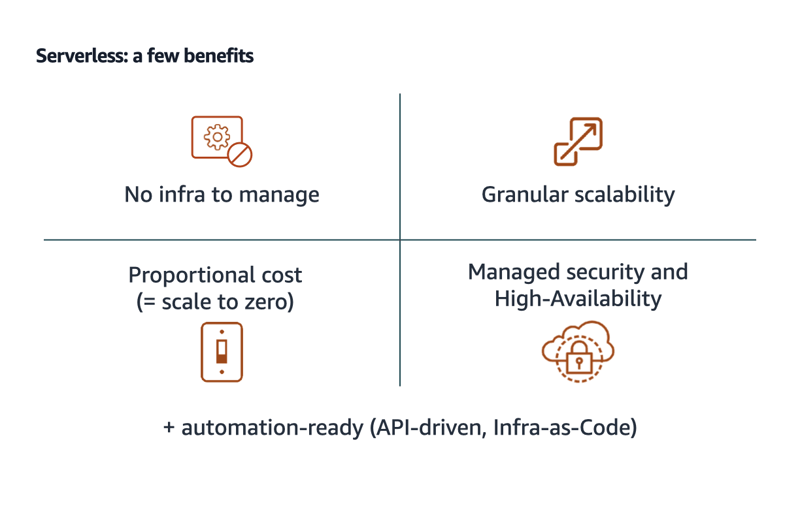
Serverless is not only about compute!
There is a plenty of solutions in the serverless ecosystem. When Serverless compute (Lambda) appeared, back in 2014, managed queues (SQS) had been around for a decade, and S3 for 8 years.
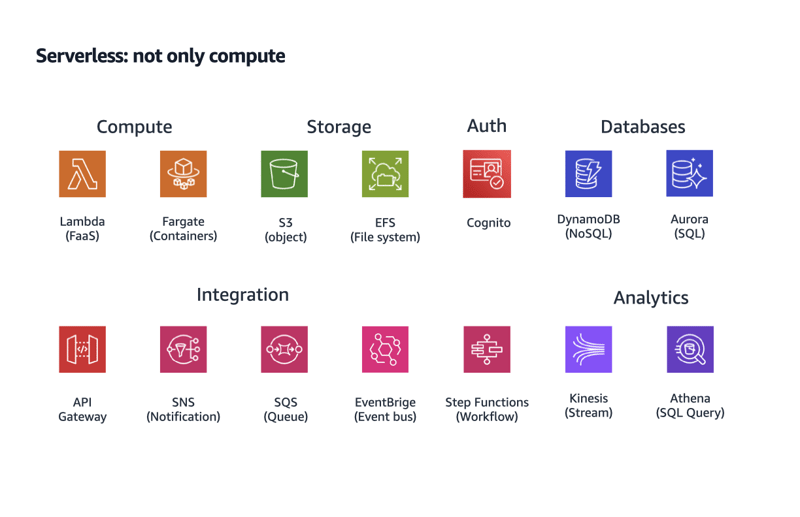
Note that in the slide above, Aurora doesn't match our strict definition of Serverless since it doesn't scale to zero (v1 scaled-to-zero but then could take minutes to start, with v2 you need to have at least 0.5 ACUs on both your writer and reader instances for the database to be ready to serve queries.
You'll find below a typical architecture for hosting a web application involving only serverless services. Hosting such an application could cost less than $1/year for a limited number of users.
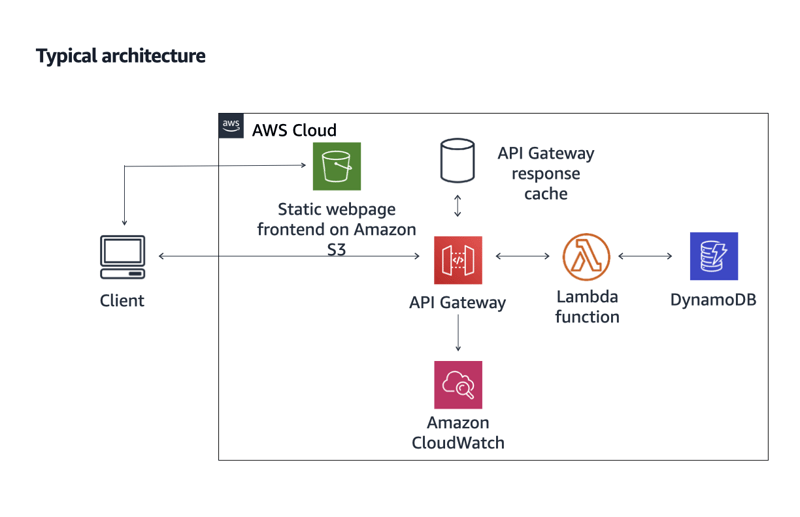
Is Serverless only for microservices?
Yes.. and no. It was designed with microservices in mind but you can still deploy a monolithic architecture (as long as you don't have long-running start up sequence every time a new environment is launched).
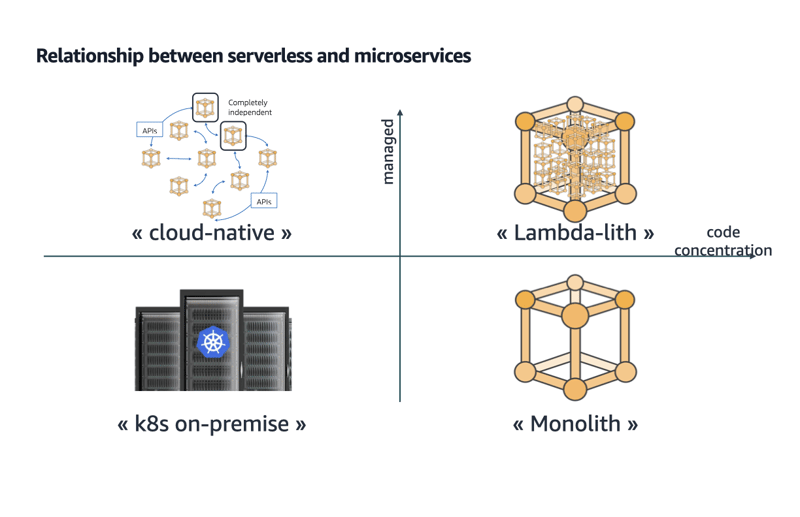
Serverless options to solve common challenge with microservices: Orchestration and Choreography
Microservices architecture make it possible to reduce coupling between applications components (using different languages, through asynchronous patterns, improving scalability by removing infrastructure-level coupling).
However, when we have multiple single-purpose functions, implementing the business logic may require coordination between functions. This coordination can implemented using two fundamental patterns.
- Orchestration: in this pattern, we control invocations of the function in an imperative way. This is often use within a business domain, when functions are delivered by a single service team. A serverless approach for this is AWS StepFunction, a workflow / state-machine. There is a nice tutorial on how to coordinate Lambda functions using StepFunction here.
- Choreography: this pattern is more relevant in cross-business-domain scenarios, with separate service teams, to maintain very limited coupling. An event bus enables application to push events and subscribe to events. Multiple consumers can subscribe to the same event and each consumer can filter whatever events they need. The core AWS service for this is EventBridge. You'll a blog post I wrote about it here.
Getting to know Lambda
Lambda is AWS's Function-as-a-Service solution. With Lambda you can deploy your code and get instant high-availability and scalability, without worrying about instances deployment and OS or runtime patching.
Lambda can used with synchronous invocations (via an API Gateway, an Application Load Balancer or a Lambda function url) or asynchronous invocatons (responding to either AWS-generated or user-generated events).
When you deploy a Lambda you chose how much memory it needs to run. Allocated CPU is proportional. You then pay based on the number of milliseconds used. For instance a 128Mb Lambda costs 1.7*10^-9$/ms. That's 164 hours of compute before you spend your first dollar.
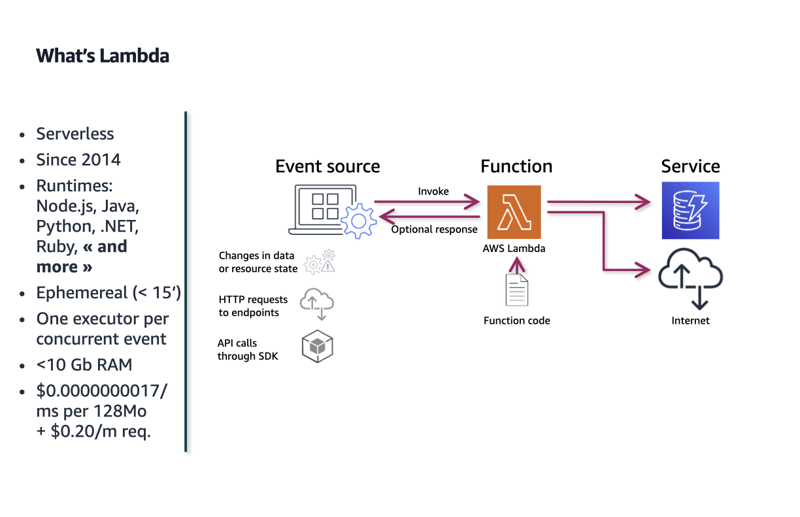
And Lambda scales. Fast. Much faster than anything else. No more 429s (or 500 if you're workload is not well protected) errors due to high traffic variation.
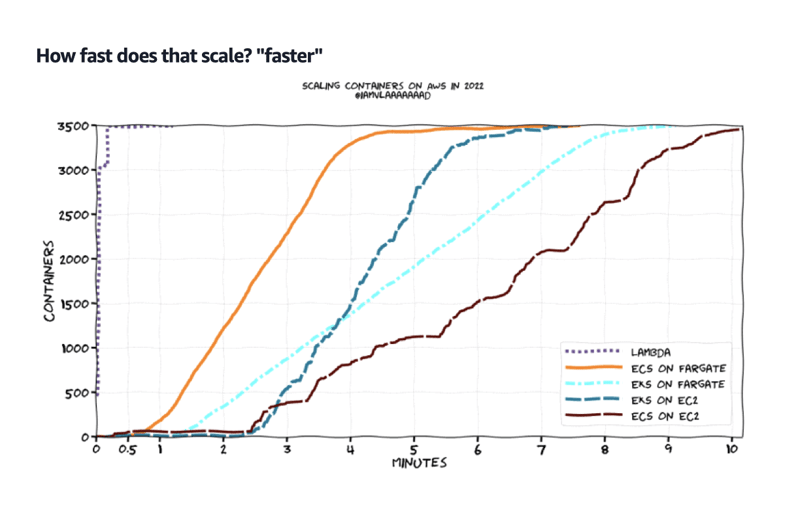
Solving the main challenge with LambdaLiths: cold starts
Lambda execution environments process only one single request at a given time, and are re-used for subsequent requests. That means that, for a Lambda function to scale, or when a Lambda function hasn't been invoked for a while, Lambda will have to start a new execution environment : that's a cold start.
If cold starts are detrimental to your application (again, that's probably better that all traffic being slow or hitting 429s), then there are a few options. AWS has a nice article about using Lambda warmers or setting provisioned concurrency to address it. In addition to those, for Java users, Lambda SnapStart features makes it possible to deliver good cold start performance, by snapshotting the microVM after the JVM inits.
What about PHP support?
The official product FAQ states it "natively supports Java, Go, PowerShell, Node.js, C#, Python, and Ruby code, and provides a Runtime API which allows you to use any additional programming languages to author your functions."
In the next blog posts in this series, we'll explain how you can run PHP on Lambda leveraging two distinct frameworks, Bref and the Lambda Web Adapter, and compare the possibilities offered by each of them.
-
 How Can I Configure Pytesseract for Single Digit Recognition with Number-Only Output?Pytesseract OCR with Single Digit Recognition and Number-Only ConstraintsIn the context of Pytesseract, configuring Tesseract to recognize single digi...Programming Posted on 2025-04-06
How Can I Configure Pytesseract for Single Digit Recognition with Number-Only Output?Pytesseract OCR with Single Digit Recognition and Number-Only ConstraintsIn the context of Pytesseract, configuring Tesseract to recognize single digi...Programming Posted on 2025-04-06 -
 How to Implement a Generic Hash Function for Tuples in Unordered Collections?Generic Hash Function for Tuples in Unordered CollectionsThe std::unordered_map and std::unordered_set containers provide efficient lookup and inserti...Programming Posted on 2025-04-06
How to Implement a Generic Hash Function for Tuples in Unordered Collections?Generic Hash Function for Tuples in Unordered CollectionsThe std::unordered_map and std::unordered_set containers provide efficient lookup and inserti...Programming Posted on 2025-04-06 -
 How to Handle User Input in Java's Full-Screen Exclusive Mode?Handling User Input in Full Screen Exclusive Mode in JavaIntroductionWhen running a Java application in full screen exclusive mode, the usual event ha...Programming Posted on 2025-04-06
How to Handle User Input in Java's Full-Screen Exclusive Mode?Handling User Input in Full Screen Exclusive Mode in JavaIntroductionWhen running a Java application in full screen exclusive mode, the usual event ha...Programming Posted on 2025-04-06 -
 How to Parse JSON Arrays in Go Using the `json` Package?Parsing JSON Arrays in Go with the JSON PackageProblem: How can you parse a JSON string representing an array in Go using the json package?Code Exampl...Programming Posted on 2025-04-06
How to Parse JSON Arrays in Go Using the `json` Package?Parsing JSON Arrays in Go with the JSON PackageProblem: How can you parse a JSON string representing an array in Go using the json package?Code Exampl...Programming Posted on 2025-04-06 -
 How to Send a Raw POST Request with cURL in PHP?How to Send a Raw POST Request Using cURL in PHPIn PHP, cURL is a popular library for sending HTTP requests. This article will demonstrate how to use ...Programming Posted on 2025-04-06
How to Send a Raw POST Request with cURL in PHP?How to Send a Raw POST Request Using cURL in PHPIn PHP, cURL is a popular library for sending HTTP requests. This article will demonstrate how to use ...Programming Posted on 2025-04-06 -
 Can You Use CSS to Color Console Output in Chrome and Firefox?Displaying Colors in JavaScript ConsoleIs it possible to use Chrome's console to display colored text, such as red for errors, orange for warnings...Programming Posted on 2025-04-06
Can You Use CSS to Color Console Output in Chrome and Firefox?Displaying Colors in JavaScript ConsoleIs it possible to use Chrome's console to display colored text, such as red for errors, orange for warnings...Programming Posted on 2025-04-06 -
 How Can I Customize Compilation Optimizations in the Go Compiler?Customizing Compilation Optimizations in Go CompilerThe default compilation process in Go follows a specific optimization strategy. However, users may...Programming Posted on 2025-04-06
How Can I Customize Compilation Optimizations in the Go Compiler?Customizing Compilation Optimizations in Go CompilerThe default compilation process in Go follows a specific optimization strategy. However, users may...Programming Posted on 2025-04-06 -
 How Can I UNION Database Tables with Different Numbers of Columns?Combined tables with different columns] Can encounter challenges when trying to merge database tables with different columns. A straightforward way i...Programming Posted on 2025-04-06
How Can I UNION Database Tables with Different Numbers of Columns?Combined tables with different columns] Can encounter challenges when trying to merge database tables with different columns. A straightforward way i...Programming Posted on 2025-04-06 -
 How Can I Efficiently Create Dictionaries Using Python Comprehension?Python Dictionary ComprehensionIn Python, dictionary comprehensions offer a concise way to generate new dictionaries. While they are similar to list c...Programming Posted on 2025-04-06
How Can I Efficiently Create Dictionaries Using Python Comprehension?Python Dictionary ComprehensionIn Python, dictionary comprehensions offer a concise way to generate new dictionaries. While they are similar to list c...Programming Posted on 2025-04-06 -
 How to Efficiently Convert Timezones in PHP?Efficient Timezone Conversion in PHPIn PHP, handling timezones can be a straightforward task. This guide will provide an easy-to-implement method for ...Programming Posted on 2025-04-06
How to Efficiently Convert Timezones in PHP?Efficient Timezone Conversion in PHPIn PHP, handling timezones can be a straightforward task. This guide will provide an easy-to-implement method for ...Programming Posted on 2025-04-06 -
 How to Resolve the \"Invalid Use of Group Function\" Error in MySQL When Finding Max Count?How to Retrieve the Maximum Count Using MySQLIn MySQL, you may encounter an issue while attempting to find the maximum count of values grouped by a sp...Programming Posted on 2025-04-06
How to Resolve the \"Invalid Use of Group Function\" Error in MySQL When Finding Max Count?How to Retrieve the Maximum Count Using MySQLIn MySQL, you may encounter an issue while attempting to find the maximum count of values grouped by a sp...Programming Posted on 2025-04-06 -
 How Can I Programmatically Select All Text Within a DIV on Mouse Click?Programmatically Selecting DIV Text on Mouse ClickQuestionGiven a DIV element with text content, how can the user programmatically select the entire t...Programming Posted on 2025-04-06
How Can I Programmatically Select All Text Within a DIV on Mouse Click?Programmatically Selecting DIV Text on Mouse ClickQuestionGiven a DIV element with text content, how can the user programmatically select the entire t...Programming Posted on 2025-04-06 -
 How to Capture and Stream stdout in Real Time for Chatbot Command Execution?Capturing stdout in Real Time from Command ExecutionIn the realm of developing chatbots capable of executing commands, a common requirement is the abi...Programming Posted on 2025-04-06
How to Capture and Stream stdout in Real Time for Chatbot Command Execution?Capturing stdout in Real Time from Command ExecutionIn the realm of developing chatbots capable of executing commands, a common requirement is the abi...Programming Posted on 2025-04-06 -
 Python Read CSV File UnicodeDecodeError Ultimate SolutionUnicode Decode Error in CSV File ReadingWhen attempting to read a CSV file into Python using the built-in csv module, you may encounter an error stati...Programming Posted on 2025-04-06
Python Read CSV File UnicodeDecodeError Ultimate SolutionUnicode Decode Error in CSV File ReadingWhen attempting to read a CSV file into Python using the built-in csv module, you may encounter an error stati...Programming Posted on 2025-04-06 -
 How Can I Efficiently Generate URL-Friendly Slugs from Unicode Strings in PHP?Crafting a Function for Efficient Slug GenerationCreating slugs, simplified representations of Unicode strings used in URLs, can be a challenging task...Programming Posted on 2025-04-06
How Can I Efficiently Generate URL-Friendly Slugs from Unicode Strings in PHP?Crafting a Function for Efficient Slug GenerationCreating slugs, simplified representations of Unicode strings used in URLs, can be a challenging task...Programming Posted on 2025-04-06
Study Chinese
- 1 How do you say "walk" in Chinese? 走路 Chinese pronunciation, 走路 Chinese learning
- 2 How do you say "take a plane" in Chinese? 坐飞机 Chinese pronunciation, 坐飞机 Chinese learning
- 3 How do you say "take a train" in Chinese? 坐火车 Chinese pronunciation, 坐火车 Chinese learning
- 4 How do you say "take a bus" in Chinese? 坐车 Chinese pronunciation, 坐车 Chinese learning
- 5 How to say drive in Chinese? 开车 Chinese pronunciation, 开车 Chinese learning
- 6 How do you say swimming in Chinese? 游泳 Chinese pronunciation, 游泳 Chinese learning
- 7 How do you say ride a bicycle in Chinese? 骑自行车 Chinese pronunciation, 骑自行车 Chinese learning
- 8 How do you say hello in Chinese? 你好Chinese pronunciation, 你好Chinese learning
- 9 How do you say thank you in Chinese? 谢谢Chinese pronunciation, 谢谢Chinese learning
- 10 How to say goodbye in Chinese? 再见Chinese pronunciation, 再见Chinese learning

























